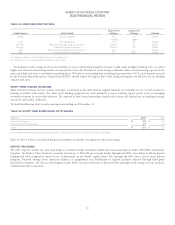American Express 2014 Annual Report Download - page 42
Download and view the complete annual report
Please find page 42 of the 2014 American Express annual report below. You can navigate through the pages in the report by either clicking on the pages listed below, or by using the keyword search tool below to find specific information within the annual report.
AMERICAN EXPRESS COMPANY
2014 FINANCIAL REVIEW
The following provides definitions for Fully Phased-in Basel III capital ratios as defined by the Basel III rules using the Standardized
Approach. All calculations are non-GAAP measures.
Fully Phased-in Basel III Common Equity Tier 1 Risk-Based Capital Ratio – The Fully Phased-in Basel III Common Equity Tier 1 risk-based
capital ratio is calculated as Common Equity Tier 1 under Fully Phased-in Basel III rules divided by risk-weighted assets under Fully Phased-
in Basel III rules.
Fully Phased-in Basel III Tier 1 Risk-Based Capital Ratio – The Fully Phased-in Basel III Tier 1 risk-based capital ratio is calculated as Tier 1
capital under Fully Phased-in Basel III rules divided by risk-weighted assets under Fully Phased-in Basel III rules.
The following table presents a comparison of our Common Equity Tier 1 and Tier 1 risk-based capital under Transitional Basel III rules to
our estimated Common Equity Tier 1 and Tier 1 risk-based capital under Fully Phased-in Basel III rules as of December 31, 2014.
TABLE 19: TRANSITIONAL BASEL III VERSUS FULLY PHASED-IN BASEL III
(Billions) CET1 Tier 1
Risk-Based Capital under Transitional Basel III $17.5$ 18.2
Adjustments related to:
AOCI (0.3) (0.3)
Transition provisions for intangible assets (0.7) (0.7)
Deferred tax assets (0.1) (0.1)
Other —0.1
Estimated Common Equity Tier 1 (CET1) and Tier 1 Risk-Based Capital under Fully Phased-in Basel III $16.4$ 17.2
Fully Phased-in Basel III Risk-Weighted Assets – The Fully Phased-in Basel III risk-weighted assets reflect our Basel I risk-weighted assets,
adjusted under Fully Phased-in Basel III rules. This includes incremental risk weighting applied to deferred tax assets and significant
investments in unconsolidated financial institutions, as well as exposures to past due accounts, equities and sovereigns. The Fully Phased-in
Basel III risk-weighted assets as of December 31, 2014 were estimated to be $134.3 billion.
Fully Phased-in Basel III Tier 1 Leverage Ratio – The Fully Phased-in Basel III Tier 1 leverage ratio is calculated by dividing Fully Phased-in
Basel III Tier 1 capital by our average total consolidated assets.
Basel III Supplementary Leverage Ratio – The supplementary leverage ratio under Fully Phased-in Basel III rules is calculated by dividing
Fully Phased-in Basel III Tier 1 capital by our total assets for supplementary leverage capital purposes under Basel III. Total assets for
supplementary leverage capital purposes reflect total consolidated assets with adjustments for Tier 1 capital deductions, off-balance sheet
derivatives, undrawn unconditionally cancellable commitments and other off-balance sheet liabilities. Total assets for supplementary
leverage capital purposes as of December 31, 2014 were estimated to be $183.1 billion.
SHARE REPURCHASES AND DIVIDENDS
We have a share repurchase program to return excess capital to shareholders. The share repurchases reduce shares outstanding and offset, in
whole or part, the issuance of new shares as part of employee compensation plans.
During the year ended December 31, 2014, we returned $5.4 billion to our shareholders in the form of dividends ($1.0 billion) and share
repurchases ($4.4 billion). We repurchased 49 million common shares at an average price of $89.60 in 2014. These dividend and share
repurchase amounts represent approximately 86.1 percent of total capital generated during the year. This distribution percentage for 2014 is
significantly greater than the on average and over time target to distribute approximately 50 percent of the capital to shareholders as
dividends or through the repurchases of common stock. The 2014 percentage results from the strength of our capital ratios and the amount
of capital we generate from net income and through employee stock plans in relation to the amount of capital required to support our
organic business growth and acquisitions.
On January 5, 2015, we submitted our comprehensive capital plan to the Federal Reserve. The capital plan includes an analysis of
performance and capital availability under certain adverse economic assumptions. The capital plan was submitted to the Federal Reserve
pursuant to its guidance on dividends and capital distributions. We expect a response from the Federal Reserve by March 11, 2015. In the
first quarter of 2015, we expect to execute share repurchases up to $1.0 billion pursuant to our capital plan that received no objections from
the Federal Reserve in March 2014. The actual number of shares that will be repurchased will be based on market conditions and employee
plan activities.
42
























